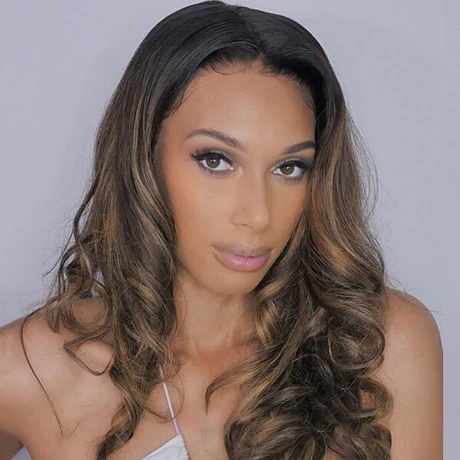To choose BOB Wig that minimizes the risk of allergic reactions, focus on avoiding irritants in non-hair components (caps, adhesives, residues) and selecting products designed for sensitivity. Below is a step-by-step guide with key considerations:
1. Prioritize Wig Caps Made of Hypoallergenic Materials
The wig cap is in direct, prolonged contact with your scalp—making it the most common source of irritation. Look for these features:
- Hypoallergenic labeling: Seek caps explicitly marked "hypoallergenic" (manufacturers test these for common irritants).
- Natural, breathable liners: Opt for caps with a cotton liner or caps made of lightweight, natural fibers (e.g., bamboo). These materials reduce sweat buildup and minimize chemical exposure compared to synthetic liners.
- Avoid latex and synthetic coatings: Steer clear of caps with elastic bands, adhesive strips, or stiffening coatings that contain latex (a major allergen) or synthetic polymers like nylon, polyester, or polyurethane (PU) (which can irritate sensitive skin). If PU is present, ensure it’s a thin, medical-grade layer (not a thick, chemical-heavy coating).
- Lace cap considerations: Full lace or lace front wigs are popular, but ensure the lace is uncoated (some lace is treated with stiffeners). Choose "Swiss lace" or "HD lace"—these are thinner and less likely to have residual chemicals than cheaper lace types.
2. Select Unprocessed or Mildly Processed Hair
While human hair itself is low-risk, residual chemicals from processing can trigger reactions. Focus on:
- Virgin human hair: This hair is unbleached, undyed, and free of harsh chemical treatments (e.g., perming, straightening). It has minimal residual shampoo, conditioner, or preservatives from production.
- Remy hair (with clean processing): If virgin hair is unavailable, choose Remy hair (cuticles intact) from brands that disclose their processing methods. Avoid wigs labeled "color-treated" or "processed" unless the brand uses plant-based, low-irritant dyes.
- Avoid pre-dyed BOB Wig with harsh dyes: Pre-colored BOB Wig may retain residues of PPD (paraphenylenediamine)—a common allergen in hair dyes. If you need color, buy uncolored virgin hair and dye it yourself with hypoallergenic, PPD-free dye.
3. Verify the Brand’s Production Standards
Reputable brands prioritize clean, low-irritant production. Check for:
- Transparent ingredient lists: Some brands disclose the materials used in caps (e.g., "100% cotton liner, latex-free elastic") and hair processing (e.g., "washed with sulfate-free shampoo").
- No harsh preservatives: Avoid BOB Wig from unknown brands (e.g., unlabeled products from discount sites)—they may use formaldehyde releasers or parabens to preserve hair/caps.
- Customer reviews for sensitivity: Look for reviews from users with "sensitive skin" or "allergies" to confirm the wig didn’t cause reactions.
4. Choose Wigs That Require Minimal Adhesives (or Use Skin-Safe Adhesives)
Adhesives (glues, tapes) are a top allergen. Minimize risk by:
- Opting for non-adhesive styles first: Choose BOB Wig with adjustable straps, combs, or clips instead of lace front/full lace wigs that require glue. These secure the wig without chemical adhesives.
- If adhesives are needed: Select lace wigs compatible with latex-free, hypoallergenic adhesives (look for brands like Walker Tape or Ghost Bond that specialize in skin-safe formulas). Avoid adhesives with acrylates (a common irritant) unless labeled "low-acrylate."
- Skip "pre-taped" wigs: Some BOB Wig come with pre-applied tape, which often contains unknown adhesives. It’s safer to apply your own tested adhesive.
5. Pre-Test and Pre-Clean the Wig
Even "safe" BOB Wig can have residual irritants—take these steps before wearing:
- Patch-test materials (critical!):
- Cut a small piece of the wig cap (or use a sample if the brand provides one) and tape it to your inner arm or scalp for 24–48 hours.
- If using adhesive, apply a tiny dot to your inner arm and wait the same period.
- Check for redness, itching, or swelling—if any occur, avoid the wig/adhesive.
- Wash the BOB Wig before first use:
- Gently wash the hair and cap with a fragrance-free, sulfate-free, paraben-free shampoo (e.g., baby shampoo or wig-specific hypoallergenic formulas).
- Rinse thoroughly (residue is a key irritant!) and air-dry completely. Do not use conditioner on the cap—only on the hair (if needed, use a hypoallergenic conditioner).
6. Avoid Wigs with Added Chemical Treatments
Steer clear of BOB Wig marketed with "anti-microbial," "waterproof," or "heat-resistant" caps unless the treatment is explicitly natural (e.g., bamboo’s inherent anti-microbial properties). Synthetic chemical coatings on caps often leach onto the scalp.
7. Prioritize Breathability
Sweat trapped against the scalp can worsen irritation. Choose:
- Lightweight caps: Avoid thick, dense caps that trap heat.
- Caps with ventilation: Look for caps with small mesh panels or open wefts (especially at the crown) to improve air circulation.
By focusing on hypoallergenic, minimally processed components and verifying safety through testing/cleaning, you can significantly reduce the risk of allergic reactions from BOB Wig. If you have a history of severe allergies, consult a dermatologist before purchasing.

